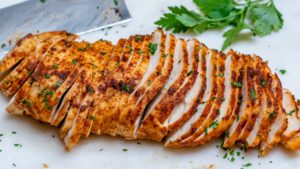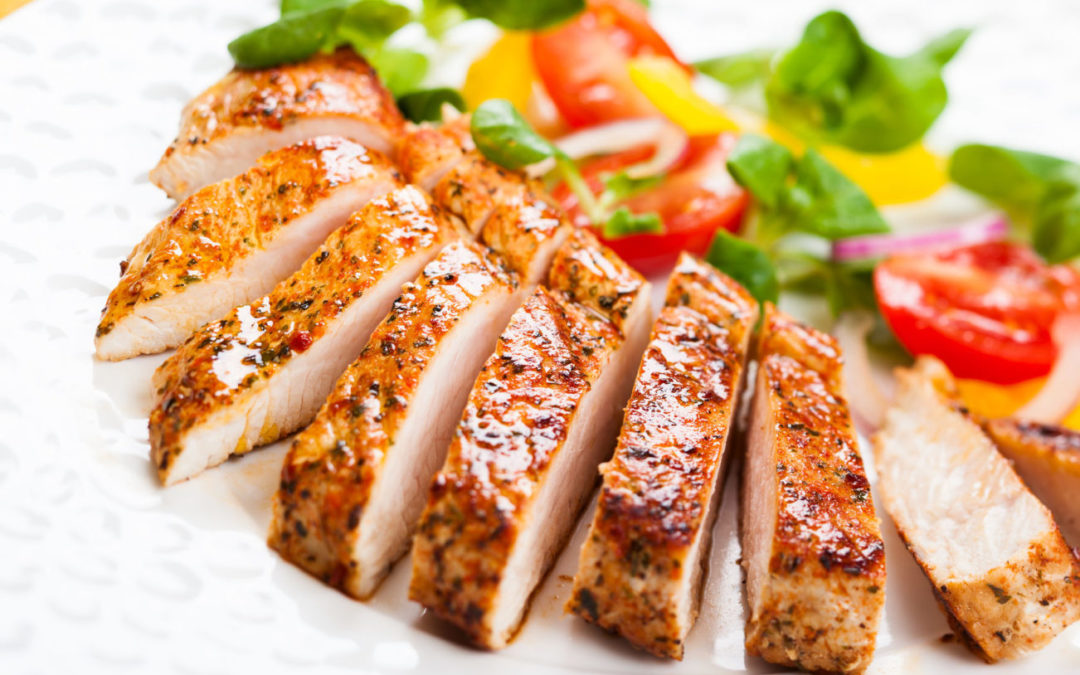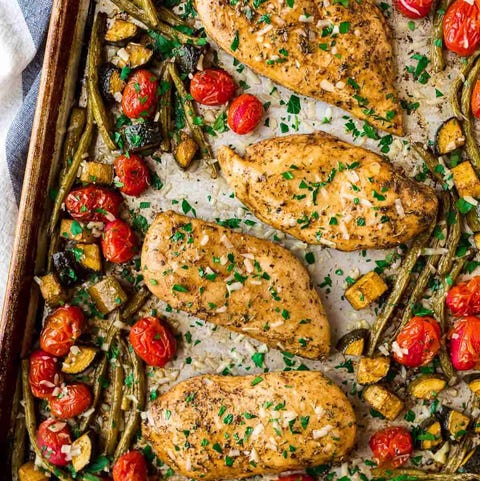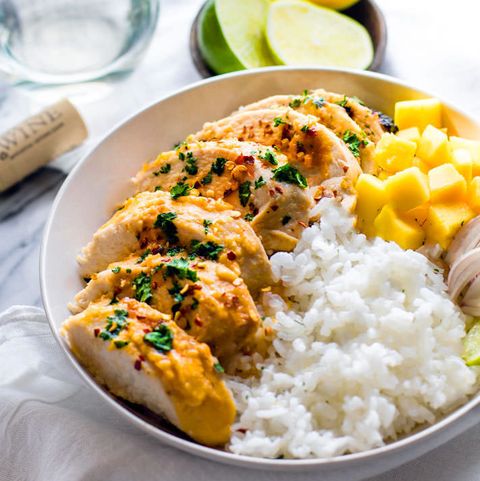For one, it has more protein than steak, pork, or turkey.
Protein is an important macronutrient for runners to get in their diets. The good news is that there are so many protein-packed foods to choose from: fish, steak, eggs, beans, legumes, nuts, and meat alternatives. Heck, even veggies have protein.
One tried-and-true lean protein source that’s stood the test of time (for non-vegans and vegetarians): chicken breast. The meat offers a whopping 28 grams of protein per 3 oz serving, which is higher than what you’d get from steak, pork, roasted turkey, lamb, and even rotisserie chicken, says Laura Iu, R.D., a nutritionist in New York City.

Okay, so it’s protein-packed, but other than that, is chicken breast really as good for you as it seems?
How do chicken breast nutrition and calories stack up?
According to the USDA, a 3.5-ounce serving of roasted chicken breast without the skin contains:
- Calories: 165
- Protein: 31 g
- Fat: 4 g
- Saturated fat: 1 g
- Carbohydrates: 0 g
- Fiber: 0 g
- Sodium: 74 mg
Now consider the differences when you keep the skin on:
- Calories: 197
- Protein: 30 g
- Fat: 8 g
- Saturated fat: 2 g
- Carbohydrates: 0 g
- Fiber: 0 g
- Sodium: 71 mg
As you can see, keeping the skin on doubles the fat and saturated fat content, but adds a modest number of calories—about 30.
One key thing to remember is that these numbers are for a 3.5-ounce serving. That’s slightly more than half of the average chicken breast. This is what you’ll get for a whole, boneless, skinless chicken breast:
- Calories: 284
- Protein: 53 g
- Fat: 6 g
- Saturated Fat: 1.7 g
- Carbohydrates: 0 g
- Fiber: 0 g
- Sodium: 127 mg
So if you eat the whole thing, you’ll be getting a lot more protein—but also consider the increase in calories and saturated fat. (Fun fact: Chickens have quadrupled in size since the 1950s, according to research published in the journal Poultry Science.)
[Build a killer midsection in the kitchen for effortless miles on the road with Eat for Abs!]
What about chicken breast’s overall nutrition?
Chicken breast obviously has a ton of protein. But it also offers 6 percent of your daily value of iron per 3.5-ounce serving, which helps carry oxygen throughout your body and supports immune system function.
Research also shows that consuming chicken breast is associated with a lower risk of developing heart disease and diabetes, per a study in the journal Food & Nutrition Research.
Chicken breast also offers an especially concentrated amount of B vitamins and zinc, which is especially great for women during pregnancy and breastfeeding. But, wait, that’s not all—it’s also a good source of bone-boosting vitamin D and calcium, according to Iu.
So rest assured, chicken is not overrated. Now, all you need to do is nail down the healthiest way to make it and you’ll be set.
So, what is the healthiest way to cook chicken breast?
One of the many perks of this powerhouse poultry is that it’s super versatile, meaning you can cook it in a number of different ways—grill it, roast it, toss it over a green salad, shred and put it into tacos or wraps, or even skewer it and smother it in peanut sauce. So many options.
But, of course, the healthiest ways to cook chicken are poaching, grilling, or baking it, says Iu. When you grill or bake, go for unsaturated plant-based oils (like EVOO or avocado oil) to minimize adding unnecessary saturated fats to your dish. And when you poach or boil it, be sure to do so on low heat, so there is minimal loss of nutrients, Iu says.
Also: Make sure to remove any tendons, blood spots, and fat before cooking.
And while removing the skin will allow for chicken with the fewest calories and saturated fat, cooking it with the skin has its fair share of perks as well. “Keeping the skin on will add a lot of flavor and helps retain moisture and juiciness,” says Taylor Chan, R.D., dietitian and personal trainer in Baltimore. “Whether to keep it on or not all depends on what’s important to you.”
Pro tip: You can always cook with the skin for enhanced flavor but nix it before you dig in.
Finally, what are the best ways to eat chicken breast?
It all depends on your health goals and flavor preferences. But, per Chan, it’s always a good idea to keep it fun and try new preparation methods. Use a spice rub one night, or a new BBQ sauce for another.
“Food should be enjoyable and not feel like a chore. So try to get away from the monotony of chicken, rice, and broccoli that so many people get trapped in,” Chan says. (Unless you’re a fan of that combo, in which case, more power to you.)
Ready to give chicken breast a go at home? Check out these nutritious recipes below.
Chicken Breasts With Quinoa and Kale
Garnishing wilted kale and warm quinoa with walnuts and onions creates a unique texture that’s sure to please your taste buds.
Per serving: 271 calories, 15 g (sat 2 g) fat, 23 g carbs, 221 mg sodium, 4 g fiber, 13 g protein
Sheet Pan Italian Chicken
All you need to make this super colorful (thanks to seasonal veggies like zucchini and tomatoes) one-pan wonder is one hour.
Per serving: 323 calories, 16 g (sat 3 g) fat, 7 g carbs, 6 g sugar, 2 g fiber, 44 g protein
Chili-Lime Mango Marinated Chicken Bowls
Fresh fruit, a splash of OJ, and a touch of white wine come together to create a tasty, summery dish. This is a great way to refresh your go-to chicken and rice duo.
Per serving: 270 calories, 10 g (sat 3 g) fat, 18 g carbs,27 g protein
A true love for sports






Recent Comments